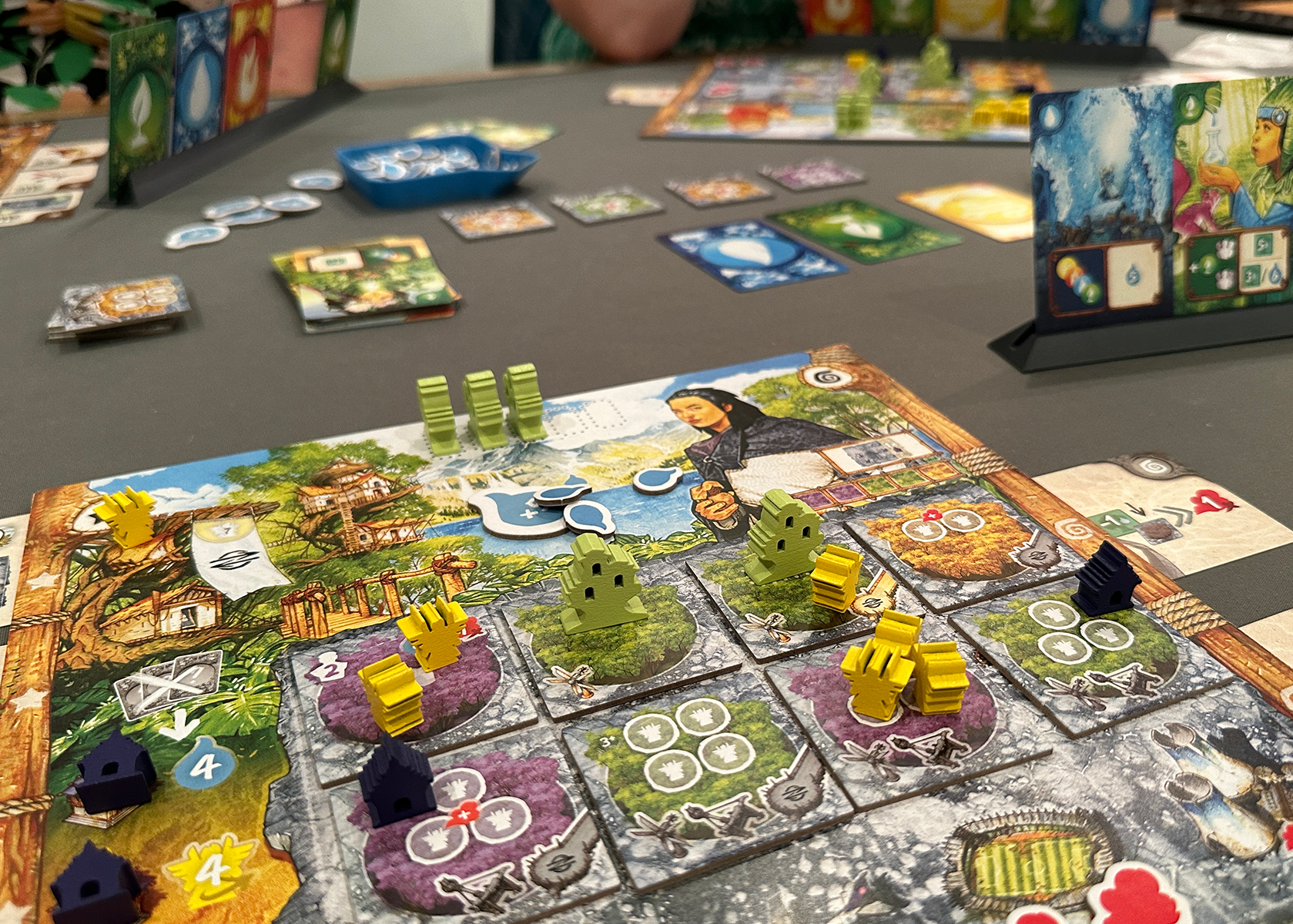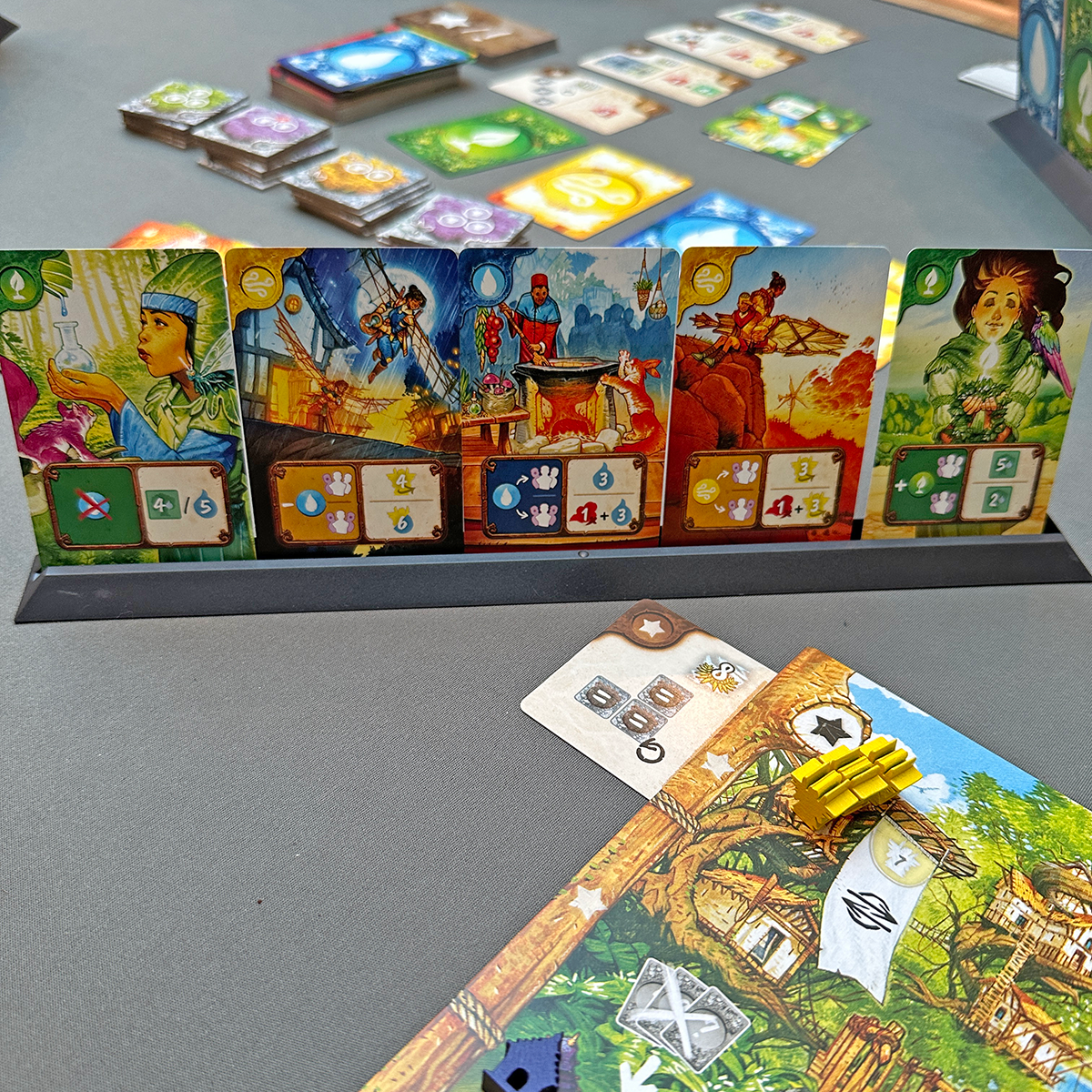Tribes of the Wind Review
Advert: this game was gifted by Hachette Board Games UK, this has not affected our opinion.
Straight off the bat, I’m gonna tell you this is NOT a game about a load of people that have eaten too many baked beans. Although, the planet has pretty much died from pollution and you’re trying to blow the pollution away and rewild the planet. The rulebook implies that the pollution, or the removal of it, has nothing to do with bottom burps. Although it doesn’t specifically say that, so perhaps it is open to interpretation. Regardless, to clear the pollution in the game you will need to ‘summon elemental magic’, which is my new favourite way of warning people that an impending purmp is on its way!
Well before this introduction gets anymore turd, let’s find out if the board game Tribes of the Wind is poop or not…

©boardgamereview.co.uk
Setup
The central play area needs space for a river of ‘Elemental’ cards and a village display. A forest display will also be required, which tiles are used depends on player count. Water and pollution tokens need to be in easy reach of all players too.
Players will draw a random board and take the matching objective cards. They will then need to set up their personal player board with tokens and components. Five elemental cards need to be drawn and placed on the provided card racks. Finally which objective cards to keep and any asymmetry in the setup has to be accounted for.
There is a little bit of set up and tear down but generally its smooth and intuitive.


©boardgamereview.co.uk
Gameplay
On your turn you will either play a card and carry out its action, discard three cards to place a temple, or build a village.
When playing a card you will often be using or comparing your neighbours’ card backs to ascertain your bonuses. These vary from having more or less of a certain type of cards or using the combined total to work out what you get. Generally, red cards help remove pollution, blue cards get water, green cards let you spend the water to build tiles, and yellow cards let you move your wind folk around your personal board, a certain number of these are required to build villages. Building villages has the additional benefit of getting a one off advantage or end-game scoring opportunities.
In addition to the above, each player has two asymmetric powers to unlock, one is achieved by arranging tiles on your board in a certain order, the other is another varying challenge. Each time you will choose a bonus from a possible four. These can really help build a strategy around.
The end game is triggered when someone has built their fifth and final village. At this point players will tally points accrued completing objectives through the game, as well as end game points from the amount of pollution removed, how many tiles have been placed, and for the buildings placed on the board.


©boardgamereview.co.uk
What it’s like
Initially, the amount of iconography to learn can seem a little daunting and unfortunately a grasp of this is required as part of the teach. It does become quite instinctive, but for those who glaze over during a teach this could be an issue. After that, the gameplay is smooth and there are plenty of strategies to explore.
The luck of the cards does come into play, but if you are willing to adapt your strategy, or clear most your hand to build a temple there is always something you can do, and this is generally how it goes! Tribes of the Wind can be played at a canter. However, gameplay is often punctuated because your neighbour, whose cards you are often using, can change on their turn and all you’re planning can be undone.

©boardgamereview.co.uk
Tribes of the Wind plays up to five people, just because it can, doesn’t mean you should! I found it really slow at five and also difficult to set up on a rectangular table so everyone could see the backs but not the fronts of the cards.
Whenever I see a two player variant, I worry a little that you won’t be getting the full game experience. However, the variant is that you use the draw deck as your neighbour’s cards. I was surprised as it worked fantastically well! Two or three player is my preference.
Players should choose their boards randomly. The asymmetry is quite well balanced but I think mixing it up would still be recommended, despite the rulebook suggesting the contrary.

©boardgamereview.co.uk
Table Presence
The Vincent Dutrait artwork sets the tone nicely for the game. The artwork on the cards is individual, some have a similar look but with subtle details swapped out that makes it fun to spot the differences.
The symbology on the cards is clear. I wish there was a reference card for the symbols, as a couple are quite similar and could be confused on early plays. Although once you are used to it, you find yourself reaching for the clarification less and less. If a period of time goes between plays I will certainly need a refresher!
The novelty of using your neighbours cards is good and the artwork on the back is clear and the included card holders work really well. These come with a minor logistical issue of making sure everyone can see the backs of your card, and not the front! Fine if you are sat at a round table like Arthurian Knights, but if you are on a rectangular table this becomes trickier at higher player counts.
All the components are good the wooden temples, villages and wind folk are the highlights here. The pollution and water tokens utilitarianly do the job.
The rulebook is good and there are some nice examples to illustrate the words. In terms of an insert, you are out of luck, you’ll be bagging it and slinging it in the box! At least it fills the box nicely so the contents don’t slosh around too badly.


©boardgamereview.co.uk
What the kids thought
George (12): I like clearing the pollution to enable me to place tiles and get the bonuses from them. I really enjoy working towards the additional scoring objectives too. The artwork gives a real picture of what’s going on and I like that.
Harrison (15): I like how the boards are asymmetric and that helps shape your strategy. I also like how you have to choose between a good one off benefit or a scoring objective, it can be a tricky decision when you build a village. It’s cool how you unlock individual player powers, being able to choose between the four options is great. The unique card art is good too!


©boardgamereview.co.uk
Final thoughts on Tribes of the Wind
Everything about the gameplay works, especially at lower player counts. I will need some persuading to play this again at five player though, as it turned what should be a 40 to 60 minute game into an absolute slog. With that sort of time investment I would rather play something more meaty.
I am concerned it won’t hit the table often enough to keep the iconography fresh, but that is probably my fault and not the game’s!
Every 100 posts I make on Instagram, I do a #100postmemento. This is a photo that showcases our games of the moment. I had one recently and my wife chose Tribes of the Wind as her pick.
I can see why she did. There is a lot to digest and strategize over. You will never quite achieve everything you hoped you would at the start of the game. While you may have an overarching plan of action, you are largely dictated by the cards in your hand, and your neighbours’ hand. This use of cards, gives a lovely unique and fresh feel to Tribes of the Wind.
Key Facts
Number of players: 2 to 5
Board Game Review Recommended Age: 12+
Publisher’s Recommended Age: 14+
Playing Time: 60 minutes
Setting Up and Take Down Time: 3 minute
Designer: Joachim Thôme
Publisher: La Boîte de Jeu / Hachette Board Games UK
RRP: £48.00
Summary
Tribes of the Wind is a very good board game that I have thoroughly enjoyed playing. I enjoy the different routes to victory and the strategies to unlock.
-
Artwork and Components
-
Complexity
-
Instructions
-
Interaction
-
Value for Money
Overall
Pros
- Beautiful artwork
- Interesting use of your own and neighbours’ cards
- Feels quite unique
- Different paths to victory
Cons
- Not recommended at five players
- Can be tricky to make the cardholders work around a table
- Some luck of the cards
- Lack of a player aid
Need more games?
If you already own Tribes of the Wind and enjoy it, or are looking for other inspiration, you might also like these similar games:
- Kodama Forest
- Terraforming Mars
- Between Two Cities Essential Edition
- 7 Wonders
Buy Tribes of the Wind
If you want to buy Tribes of the Wind after reading our review click on one of our affiliate links below (note there has been no affiliate links until this point)
Reviewer’s Note
For clarity: we don’t get paid for our reviews. However, we were kindly gifted this game by Hachette Board Games UK. We have tried not to let this affect our review in any way.
We may however earn a tincy wincy commission if you buy a game having clicked one of our affiliate links like the one above… this hopefully gives us a bit of pocket money towards hosting costs and new games to review!
As an Amazon Associate I earn from qualifying purchases.
Board Game Review is a brand ambassador for Out of Town Games.
We also are an affiliate of Board Game Prices, a price comparison website for Board Games.
These affiliate advertising programs are designed to provide a means for sites to earn advertising fees by advertising and linking to their websites.





